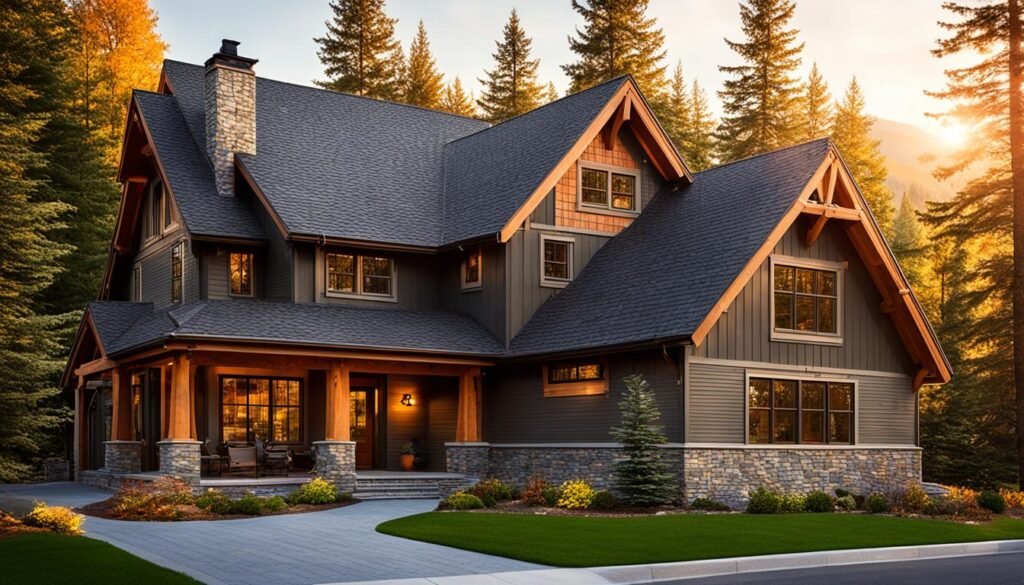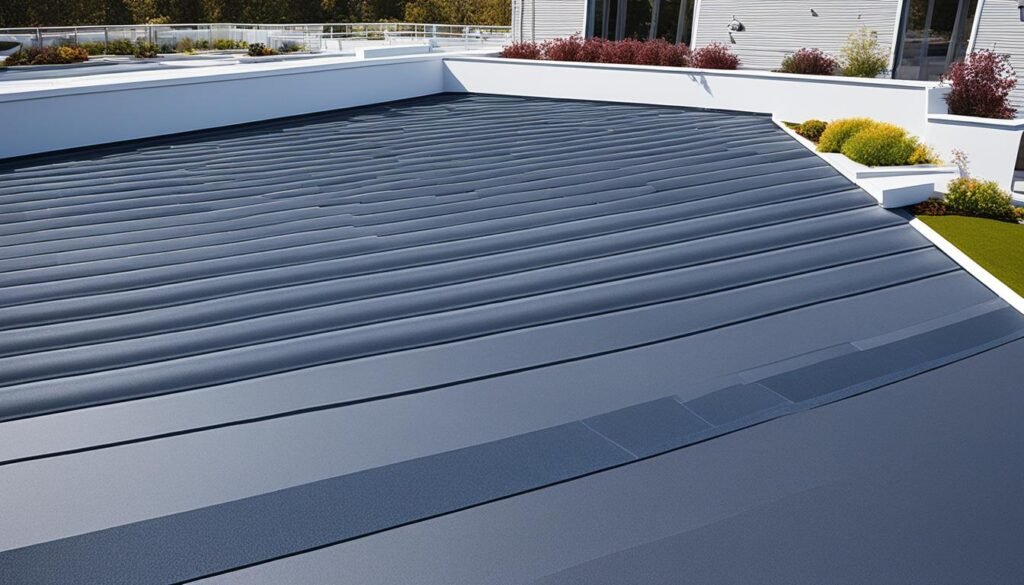Did you know that the choice between a flat roof and a pitched roof can have a significant impact on your home? It’s a decision that will not only affect the overall look of your house but also its functionality and long-term maintenance costs. Understanding the pros and cons of each roofing option is essential to make an informed choice that suits your needs and preferences.
- Choosing the right roof for your home is a crucial decision that affects its appearance, functionality, and maintenance costs.
- Flat roofs offer cost savings during installation and provide additional usable space, but they require more maintenance and are prone to leaks.
- Pitched roofs have a longer lifespan, better water drainage, improved insulation, and enhance the curb appeal of your home, but they are generally more expensive upfront.
- Consider factors such as budget, aesthetics, and maintenance preferences when deciding between a flat or pitched roof.
- Consulting with a professional roofing contractor can help you make an informed decision based on your specific needs.
Benefits of Flat Roofs
When it comes to roofing options for your home, flat roofs offer several advantages that make them a popular choice among homeowners. Let’s explore the pros and cons of flat roofs to help you determine if they are the right choice for your needs.
Affordability: One of the primary benefits of flat roofs is their cost-effectiveness. Flat roofs are generally cheaper to install compared to pitched roofs. The lower cost of labor and materials makes flat roofs a more affordable option for homeowners.
Usable Space: Flat roofs provide additional usable space that can be utilized in various ways. You can use the flat roof for the installation of HVAC units, solar panels, or even as a recreational area such as a rooftop garden or patio. This extra space can enhance the functionality and aesthetics of your property.
Maintenance and Repairs: Maintaining and repairing flat roofs is relatively easier and safer compared to pitched roofs. With a flat surface, accessing the roof for routine maintenance or repairs is safer as there is less risk of slipping and falling. This accessibility can save you time, effort, and potentially reduce the maintenance costs.
However, it’s crucial to consider the cons of flat roofs as well. Flat roofs may have some drawbacks, such as their tendency to retain water and require regular inspection to prevent leaks. Additionally, the lack of slope can result in the accumulation of debris, which needs to be regularly cleaned to ensure optimal performance.
Pros and Cons of Flat Roofs
| Pros | Cons |
|---|---|
| Cost-effective installation | Prone to water retention and leaks |
| Extra usable space for various purposes | Potential debris accumulation |
| Easier and safer maintenance and repairs | Requires regular inspection to prevent issues |
Benefits of Pitched Roofs
Pitched roofs, although less common in residential properties, offer several advantages as well. Firstly, pitched roofs have a longer lifespan compared to flat roofs. The slope of the roof allows for better water drainage, reducing the risk of leaks and water damage.
Additionally, pitched roofs offer better insulation compared to flat roofs. With more space for insulation materials, pitched roofs provide improved energy efficiency, resulting in lower heating and cooling costs. This makes them a sustainable choice for homeowners looking to reduce their carbon footprint and save on energy bills.
Pitched roofs also provide a more traditional and aesthetically pleasing appearance. The architectural appeal of a pitched roof enhances the overall curb appeal of your home, adding value and visual charm.
When it comes to roofing materials comparison, pitched roofs offer a wider range of options, allowing homeowners to choose from materials such as asphalt shingles, metal, clay tiles, or cedar shakes. Each material has its unique characteristics in terms of durability, maintenance requirements, and cost, providing homeowners with more flexibility in selecting the most suitable roofing material for their needs.
In summary, the benefits of pitched roofs include:
- Longer lifespan
- Better drainage and reduced risk of leaks
- Improved insulation and energy efficiency
- Enhanced curb appeal
- Wide range of roofing material options
Choosing a pitched roof can provide you with a durable, well-insulated, and visually appealing roofing solution for your home.
| Benefits of Pitched Roofs | Flat Roofs |
|---|---|
| Longer lifespan | Shorter lifespan |
| Better drainage and reduced risk of leaks | Increased risk of leaks |
| Improved insulation and energy efficiency | Less insulation and higher energy costs |
| Enhanced curb appeal | Less aesthetically pleasing |
| Wide range of roofing material options | Limited material options |

| Roofing Material | Durability | Maintenance | Cost |
|---|---|---|---|
| Asphalt Shingles | High | Moderate | Affordable |
| Metal | High | Low | Moderate |
| Clay Tiles | High | Moderate | Expensive |
| Cedar Shakes | Moderate | High | Moderate |
Cost Comparison: Flat Roof vs. Pitched Roof
When it comes to choosing between a flat roof and a pitched roof, cost is a significant factor to consider. In general, flat roofs tend to be less expensive to install compared to pitched roofs. The lower labor and materials cost of flat roofs make them a more budget-friendly option.
However, it’s important to consider the long-term costs as well. Flat roofs require more maintenance and are more prone to leaks, which can result in additional expenses over time. The need for regular inspections and repairs adds to the overall cost of maintaining a flat roof.
On the other hand, pitched roofs may have a higher upfront cost due to the more complex installation process and the use of additional materials. However, pitched roofs tend to have a longer lifespan and require less maintenance compared to flat roofs. The sloped design allows for better water drainage, reducing the risk of leaks and water damage. Ultimately, this means fewer repair costs in the long run.
Let’s explore the cost comparison between flat roofs and pitched roofs in more detail:
| Cost Factors | Flat Roof | Pitched Roof |
|---|---|---|
| Labor Cost | Lower | Higher |
| Materials Cost | Lower | Higher |
| Maintenance Cost | Higher | Lower |
| Repair Cost | Higher | Lower |
| Lifespan | Shorter | Longer |
As shown in the table above, flat roofs generally have lower labor and materials costs compared to pitched roofs. However, they require higher maintenance and are more prone to leaks, resulting in additional repair costs. On the other hand, pitched roofs have a higher upfront cost but tend to have a longer lifespan and require less maintenance.
In conclusion, when it comes to cost comparison between flat roofs and pitched roofs, it’s essential to consider both the initial installation expenses and the long-term maintenance costs. Assessing the specific needs and budget constraints of your project will help you make an informed decision on the most suitable roof type for your home.

Conclusion
When it comes to choosing the right roof for your home, the decision between a flat roof and a pitched roof should be based on various factors that are specific to your needs. Flat roofs offer affordability and provide additional usable space for installations or recreational areas. However, they do require more maintenance and are prone to leaks over time. On the other hand, pitched roofs may have a higher upfront cost but offer benefits like longer lifespan, better drainage, and improved insulation. These roofs also add a traditional and aesthetically pleasing look to your home.
Ultimately, when choosing between a flat roof and a pitched roof, you should consider your budget, aesthetic preferences, and maintenance expectations. Consulting with a professional roofing contractor is essential as they can provide expert advice and guide you in making the right decision. Whether you prioritize affordability, space utilization, or long-term durability, they will help you choose the best roofing option for your home.
So, take the time to evaluate your needs and consult with a professional. Choosing the right roof for your home is a significant investment, and finding the balance between cost, functionality, and aesthetics will ensure that you make a decision that fits your unique requirements perfectly.
FAQ
What are the benefits of a flat roof?
Flat roofs are cheaper to install, provide more usable space, and offer a safer environment for maintenance and repairs.
What are the benefits of a pitched roof?
Pitched roofs have a longer lifespan, better water drainage, improved insulation, and a more traditional and aesthetically pleasing appearance.
Are flat roofs more affordable than pitched roofs?
Flat roofs are generally less expensive to install but may require more maintenance and have a higher risk of leaks, resulting in potential long-term costs.
Why choose a pitched roof over a flat roof?
Pitched roofs have a longer lifespan, better water drainage, improved insulation, and enhance the curb appeal of your home.
How do I determine the best roofing option for my home?
Consider factors such as budget, aesthetics, and maintenance preferences, and consult with a professional roofing contractor for expert guidance.